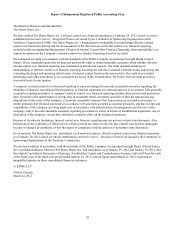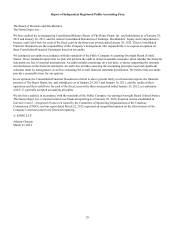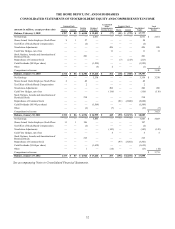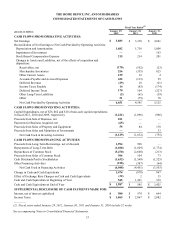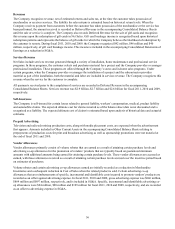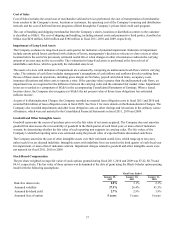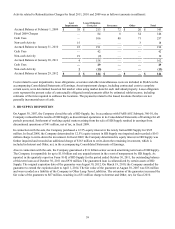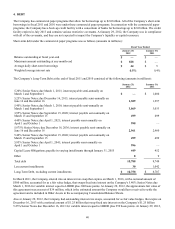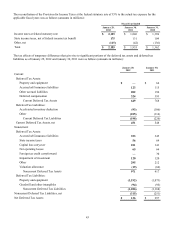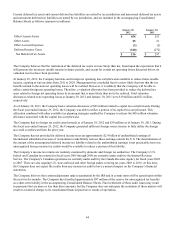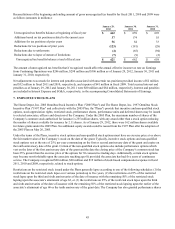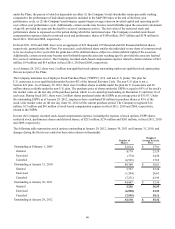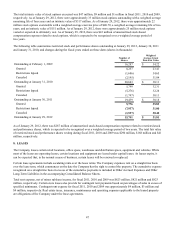Home Depot 2011 Annual Report Download - page 44
Download and view the complete annual report
Please find page 44 of the 2011 Home Depot annual report below. You can navigate through the pages in the report by either clicking on the pages listed below, or by using the keyword search tool below to find specific information within the annual report.
38
Derivatives
The Company uses derivative financial instruments from time to time in the management of its interest rate exposure on
long-term debt and its exposure on foreign currency fluctuations. The Company accounts for its derivative financial
instruments in accordance with the Financial Accounting Standards Board Accounting Standards Codification ("FASB ASC")
Subtopic 815-10. The fair value of the Company’s derivative financial instruments is discussed in Note 11.
Comprehensive Income
Comprehensive Income includes Net Earnings adjusted for certain gains and losses that are excluded from Net Earnings
under U.S. generally accepted accounting principles. Adjustments to Net Earnings and Accumulated Other Comprehensive
Income consist primarily of foreign currency translation adjustments.
Foreign Currency Translation
Assets and liabilities denominated in a foreign currency are translated into U.S. dollars at the current rate of exchange on the
last day of the reporting period. Revenues and expenses are generally translated using average exchange rates for the period
and equity transactions are translated using the actual rate on the day of the transaction.
Segment Information
The Company operates within a single reportable segment primarily within North America. Net Sales for the Company
outside the U.S. were $8.0 billion, $7.5 billion and $7.0 billion for fiscal 2011, 2010 and 2009, respectively. Long-lived assets
outside the U.S. totaled $3.1 billion and $3.2 billion as of January 29, 2012 and January 30, 2011, respectively.
Reclassifications
Certain amounts in prior fiscal years have been reclassified to conform with the presentation adopted in the current fiscal
year.
2. RATIONALIZATION CHARGES
In fiscal 2008, the Company reduced its square footage growth plans to improve free cash flow, provide stronger returns for
the Company and invest in its existing stores to continue improving the customer experience. As a result of this store
rationalization plan, the Company determined that it would no longer pursue the opening of approximately 50 U.S. stores that
had been in its new store pipeline. The Company expects to dispose of or sublet any remaining pipeline locations over
varying periods. The Company also closed 15 underperforming U.S. stores in the second quarter of fiscal 2008, and the
Company expects to dispose of or sublet any remaining locations over varying periods.
Also in fiscal 2008, the Company announced that it would exit its EXPO, THD Design Center, Yardbirds and HD Bath
businesses (the "Exited Businesses") in order to focus on its core The Home Depot stores. The Company closed the Exited
Businesses in the first quarter of fiscal 2009 and expects to dispose of or sublet any remaining locations over varying periods.
These steps impacted approximately 5,000 associates in those locations, their support functions and their distribution centers.
Finally, in January 2009 the Company also restructured its support functions to better align the Company’s cost structure.
These actions impacted approximately 2,000 associates.
The Company did not incur any material charges related to these actions (collectively, the "Rationalization Charges") in fiscal
2011 and 2010 and recognized $146 million and $951 million in total pretax charges for fiscal 2009 and 2008, respectively.
The Company does not expect any further material charges related to these actions.


